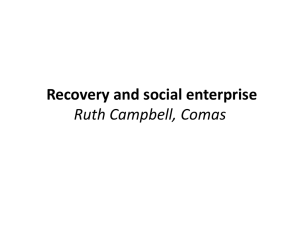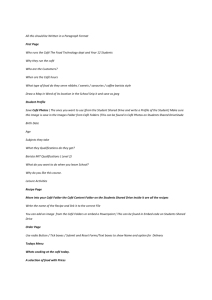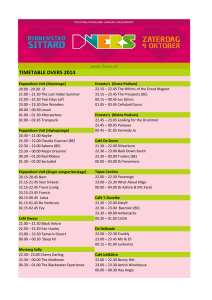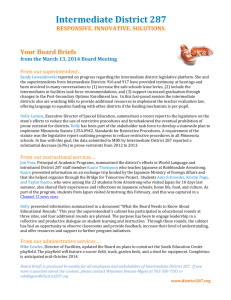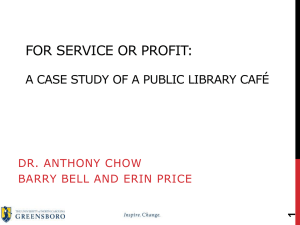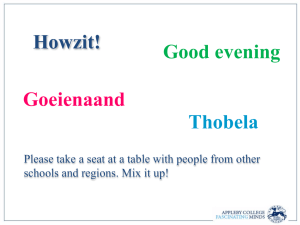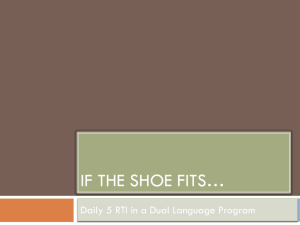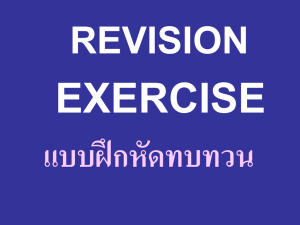Daily 5 and CAFÉ workshops
advertisement
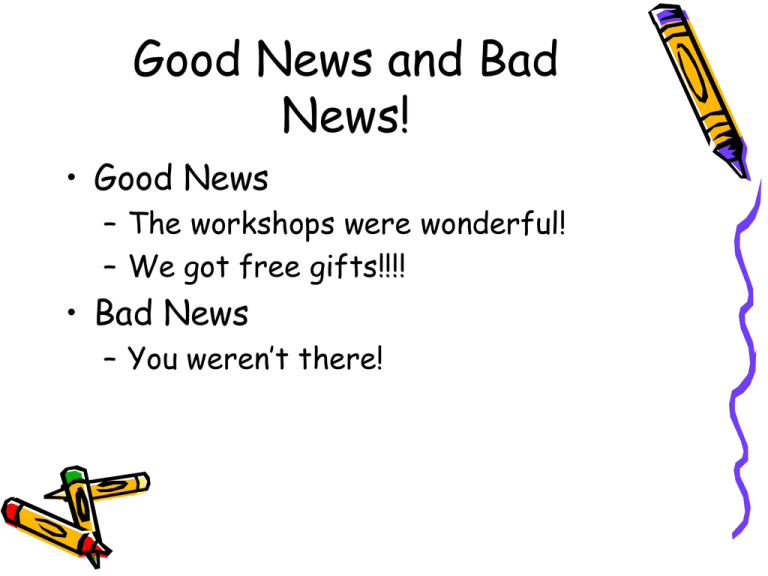
Good News and Bad News! • Good News – The workshops were wonderful! – We got free gifts!!!! • Bad News – You weren’t there! Daily Five • A student-driven management structure designed to fully engage students in reading and writing • Creates routines and procedures that foster independent literacy that are ingrained to the point of being habit Public web page • www.dailycafe.com/public/398.cfm • www.dailycafe.com/public/410.cfm • Websites with all the handouts we received • They are writing a book on how to launch the Daily Five and Café together. There are 3 articles on the website so far you can read. • P.S. There is also a Daily Five math Wednesday – Daily 5 • Basic overview of management process and rationale for Daily 5 • Gave some tips for implementation • Highlighted difference between book and “tweaks” they have included • Delineated differences between intermediate and primary • Encourage adjustments within your personal style, class climate, and curriculum. Greatest needs for success! • Strong professional support – The sisters had each other – Critical friend • Strong administration support • Patience and organization What the research says . .. • READ! • Students should read 80% of the time and receive 20% quality direct instruction • However, students generally receive 20% reading time and 80% instruction • What Really Matters for Struggling Readers by Richard Allington Brain Research: reasoning for mini lesson structure • # of years old = # of minutes of core direct instruction – I don’t believe this hold true after 35 years of age!!!!! Structure • 2-3 rounds (20-30min) sandwiched by mini lessons (7-10min). Comprehension should be the first round. • Introduce 2 components, read to self and writing, then allow choice; continue to teach remaining components. (this is different from what the book says.) • Choice is given after 8-10 days determined by class * Intermediate – build stamina to 40 mins, with 2 rounds, choice is determined between reading and writing • Kindergarten – build stamina to 15-20 mins, with 2 rounds --determine structure based on class and curriculum --- delete least desirable model first time Will he/she be a better reader if they do these things? • As you present mini lessons, small lessons, and conferring, the students have a sense urgency with their time, learning and behavior at school and hold each other responsible by encouraging and supporting each other. • *Kindergarten --- Only work on Read whole time and Stay in one spot as key behaviors What do you think??? • If students can’t do the task they need a teacher. • If students can do the task but won’t, they need a manager. Trouble shooting • • • • • • • Tools and contracting Levels of support for barometer children Reflect on teaching practice Group Dynamics In class modifications In class gradual release modifications Whole school support Stamina – before you introduce new component make sure students have built stamina • Intermediate 12-14 min • Primary 10-12 min • Kindergarten 7-8 Modeling Modeling Modeling Modeling • Muscle memory: • Feel it wrong way • Feel it right way Book Shopping You know your class but --Once a week – Fridays? During conferences on as need Before school Read to Someone • You are in control • Helps student work on fluency and expression • Choose partners • Minimize numbers • Use randomization (pairs of cards) • Partner with stuffed animal • Teach EEKK Word Work • Use your own program • Intermediate should incorporate with Work on Writing (first 10 minutes) • Keep materials to a minimum --- find a storage space to help with management • Essential writing foundations for writing Listen to Reading • • • • Start page on website Computer, MP3’s , Cassette Players Own headphones!!!!!!!!!!!!! Students learn more words, expanding their vocabulary and helping them to become better readers Once up and going • Focus lesson: Comprehension, Accuracy, Fluency, or Expand vocabulary • Check in-class list on clipboard • Check in with choice • Always go in same order, just start someplace different each day, so they know when their turn is coming • All kids stay put until all choices have been given or can check in and go, depending on the class • Use chimes to get children's attention Café Board • 4 components set up across the top • As a strategy is introduced it is put up on a sentence strip under the category by a child • Children put sticky notes under strategy they are working on. They tell you what it is at check in time. Why CAFÉ? • Do our assessments inform our instruction? – Drive/ evaluate??? – Reading groups should be based on strategies needed, not levels. – It is not guided reading, but guiding readers! -How do you organize our paperwork to help us inform our instruction? CAFÉ Menu • Guide for instruction • Menu in classroom is a visual aid to help student/ teaches learn to elicit reading process and strategies during each reading experience • Don’t let your teaching go out the door! DVD’s • We have basic DVD with CD of forms to use for your data notebook --- pensieve • We also received Intermediate level – Parrs has Word Work and Leadership DVD – Other topics are available for $199 per --- CAFÉ think abouts . . . • *Intermediate, address fluency and accuracy in 1-1 or small group, concentrate on comprehension and vocabulary for whole group instruction • CAFÉ menu to guide instruction but student behaviors are the key • Grading – touch points with daily small group and individual:1-below, 2-approaching, 3-meeting,4-exceeding • When do you move on to a new strategy? After 4-5 opportunities with 3’s and 4’s as touch points. • Determine growth with success overtime Build your community . . . • Don’t be tempted to put up “pre made” anchor charts • Create this learning together • Remember the one who works the most, learns the most! The Pensive: A Conferring Notebook • Should only be 1 inch binder • Has a reading and writing keeping track form and an appointment calendar, curriculum calendar, small group form, strategy group and instruction form, reading conferring form, writing conferring form, and Café menu to highlight Things to think about . . . • Explicit instruction for behaviors • Go slow, to move fast • No longer teaching the book we are teaching how to access the strategies – How does this align with curriculum? • Least number of teachers for students per student is better; set common goals based of student observations with in the Daily 5 Continued . . . • Any assessment is only as good as the action that arises from it. • What does flexible strategy groups look like? Video • Fair is not always equal! “Focus on this child . . . . . . this moment.” Next Steps . . . • Monthly meetings – Website, sharings, DVD’s – Critical Friends • Planning/ sub observations/ reflections • Different grades/ within teams?
